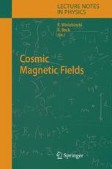Search
Search Results
-
Magnetic Fields in Galaxies
Magnetic fields are a major agent in the interstellar medium. They contribute significantly to the total pressure which balances the gas disk against...
-
Magnetic Fields in Galaxy Systems, Clusters and Beyond
The discovery of significant magnetic fields beyond our Milky Way was unwittingly made in the early 1950’s when new “discrete” cosmic radio sources...
-
Stellar Magnetic Fields
Stellar magnetic fields are directly detected or inferred across the whole Hertzsprung--Russell Diagram. Attention in this chapter is concentrated on...
-
Magnetic Fields in Diffuse HI and Molecular Clouds
The diffuse interstellar HI is the matrix within which many molecular clouds reside and the medium that soaks up the energy injected by sources such...
-
Magnetic Fields in the Early Universe
A substantial magnetic field could conceivably have been generated in the ultra-early Universe. However, the relevant physics at those eras is very...
-
Inflation
The optimistic picture for the explanation of the baryon-antibaryon asymmetry that we apparently obtain with grand unified theories has one serious...
-
Standard Synthesis
One of the two most important observations that indicate a hot past of the universe is the universal distribution of helium and deuterium. Deuterium,...
-
Basics
Telescopes of all kinds look deep into the sky and find planets, stars, the Milky Way, other galaxies, clusters of galaxies, the large-scale...
-
Topological Quasi-Particles
The subject of topology is the set of properties of relative positions that can be defined without the use of metric properties. A metric induces a...
-
Anthropic Aspects
Cosmology attempts to understand the observable metagalaxy as a representative part of the universe and as a necessary consequence of the laws that...
-
Higher Dimensions
The invariance group of mechanics and field theory tells us that space has three dimensions, and space-time four. Nearly all physical theory uses...
-
Planet Formation
Motivating the study of planet formation is not difficult for any curious audience. One of the fundamental human questions is that of origins: “where...
-
Orbit Dynamics, Stability and Chaos in Planetary Systems
Let us start with a problem of dynamical biology, which was posed about 800 years ago by Fibonacci1
-
The RASS-SDSS Galaxy Cluster Survey
Solid observational evidences indicate a strong dependence of the galaxy formation and evolution on the environment. In order to study in particular...
-
SED Diagnostics of Submillimetre Galaxies
We apply an evolutionary SED model of starbursts to submm galaxies, in order to predict the present-day colour, magnitude, and size of submm...
-
Extremely Red Galaxies: Dust Attenuation and Classification
The “extremely red galaxies” (ERGs) constitute a controversial population in deep near-IR surveys. Their extremely-red observed colours (I...
-
Galaxy Evolution in Three Dimensions: Time, Space and Mass
There are three major axes to describe the evolution of galaxies, namely, time (redshift), space (environment) and mass (stellar mass). In this...
-
A Multiwavelength Survey of Luminous Compact Blue Galaxies from z=3 to z=0
Luminous Compact Blue Galaxies (LCBGs) are small starburst systems that dominate the number density of galaxies at intermediate redshifts. LCBGs have...
-
Local Redshift Surveys and Galaxy Evolution
We present observations of galaxy environmental dependencies using data from the 2dF Galaxy Redshift Survey. From a combined analysis of the...
-
A Study of Distant Lyα Emitters in Overdense Regions
Recently, we conducted a Very Large Telescope (VLT) large program to search for forming clusters by looking for overdensities of Lyα emitters around...
